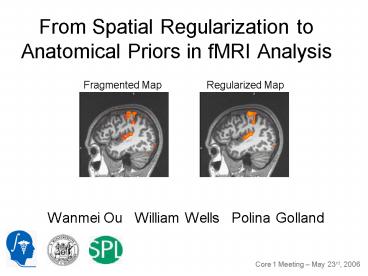From Spatial Regularization to Anatomical Priors in fMRI Analysis
1 / 28
Title:
From Spatial Regularization to Anatomical Priors in fMRI Analysis
Description:
Road Map. Background and Motivation. Markov Random Field (MRF) and Anatomical Guided MRF Model ... Activation maps. MRF Anatomical Information ... –
Number of Views:87
Avg rating:3.0/5.0
Title: From Spatial Regularization to Anatomical Priors in fMRI Analysis
1
From Spatial Regularization to Anatomical Priors
in fMRI Analysis
Fragmented Map
Regularized Map
- Wanmei Ou William Wells Polina Golland
Core 1 Meeting May 23rd, 2006
2
Main Contributions
- Propose new spatial regularization method
Incorporating Anatomical Information - Empirically Compare proposed methods with
traditional methods
3
Road Map
- Background and Motivation
- Markov Random Field (MRF) and Anatomical Guided
MRF Model - Mean Field Approximation Solver
- Experimental Evaluation
- Conclusions
4
Road Map
- Background and Motivation
- Markov Random Field (MRF) and Anatomical Guided
MRF Model - Mean Field Approximation Solver
- Experimental Evaluation
- Conclusions
5
From fMRI Images to fMRI Analysis
Image Acquisition
fMRI
MRI
Task protocol Auditory, Vision, etc.
Spatial Regularization
Voxel-by-voxel detector
Threshold
Activation Map Scatter activation
6
Road Map
- Background and Motivation
- Markov Random Field (MRF) and Anatomical Guided
MRF Model - Mean Field Approximation Solver
- Experimental Evaluation
- Conclusions
7
Goal and Approaches
Goal Recover True Activation through Spatial
Regularization
Our Approach
- Incorporate MRF into General Linear Model (GLM)
Statistic - Include Anatomical Information into MRF
8
Detailed Approaches
Our Approach
- 1. Incorporate MRF into GLM Statistic
- Capture spatial dependency
- Overcome over-smoothing effect
- 2. Include Anatomical Information into MRF
- Activation is more likely in gray matter
- Spatial dependency is strong within tissue type
Activation Maps
MRF
MRI
Synthetic Ground Truth
Segmentation Gray, White, Other
9
General Linear Model (GLM)
Protocol-Independent Signal
Two Hypotheses
Not-active voxel
Active voxel
Protocol-Dependent Signal
GLM
ML Estimate
F or T statistic
P-value
Traditional Approach
General Log Likelihood Ratio (Cosman, 04)
Our Approach
10
Markov Random Field
Spatial Priors
Likelihood
-- Hidden Activation State -- Noisy
Observation/Statistic
MAP Estimate
11
Incorporating Anatomical Information
Combine activation state tissue type
MRI
Segmentation
-- Hidden Activation State -- Tissue Type
MAP Estimate
-- Segmentation Label -- Noise Statistic
12
Markov Random Fields Solvers
- Binary MRF Min-Cut/Max-Flow (Min-Max) Binary
MRF Only - Gibbs Sampling Slow
- Simulated Annealing Slow
- Belief Propagation Fast, Approximation
- Mean Field Fast, Approximation
13
Road Map
- Background and Motivation
- Markov Random Field (MRF) and Anatomical Guided
MRF Model - Mean Field Approximation Solver
- Experimental Evaluations
- Conclusion and Future work
14
Mean Field
- Approximate by
- Iterative up-date rule
Belief Prob. Of voxel is active
- Approximated MAP
15
Mean Field
Similar up-date rule while incorporating
anatomical information
Approximated MAP
16
Alternative Anatomically Guided Filters
- No smoothing with Anatomical Information
- Suppress all activation in the non-gray matter.
- Anatomically Guided Gaussian Filter
- Adjust weights based on segmentation labels.
17
Road Map
- Background and Motivation
- Markov Random Field (MRF) and Anatomical Guided
MRF Model - Mean Field Approximation Solver
- Experimental Evaluation
- Synthetic Data
- Real fMRI Data
- Conclusions
18
Low SNR Fragmented Activation Maps
Experiments Synthetic Data Sets
Noise SNR -6.3dB
Noise SNR -9.3dB
Activation Maps
Threshold False positive 0.05
GLM Detector
Forward Model
Synthetic Ground Truth
19
Experiments Synthetic Data Sets
Noise
GLM with different smoothing methods
Forward Model
Synthetic Ground Truth
- No Smoothing
- No Smoothing w/ Anatomical Info
- Gaussian Smoothing w/o Anatomical Info
- Gaussian Smoothing w/ Anatomical Info
- MRF w/o Anatomical Info
- MRF w/ Anatomical Info
20
ROC Analysis
Without Anatomical Information Min-Max (Exact
Solver) vs. Mean Field (Approximation)
SNR -6dB
SNR -9dB
21
ROC Analysis
Without Anatomical Information MRF (Mean Field)
vs. Gaussian Smoothing
SNR -6dB
SNR -9dB
22
ROC Analysis
With Anatomical Information MRF (Mean Field) vs.
Gaussian Smoothing
SNR -6dB
SNR -9dB
23
Road Map
- Background and Motivation
- Markov Random Field (MRF) and Anatomical Guided
MRF Model - Mean Field Approximation Solver
- Experimental Evaluation
- Synthetic Data
- Real fMRI Data
- Conclusions
24
Evaluation on Real Data
Ground Truth
GLM
Majority Voting
GLM
8 task epochs
comparisons
GLM with various spatial regularizers
2 task epochs
25
Activation Maps Comparison
Anat No Smoothing
Gaussian MRF
Ground Truth No SmoothingAnat
GaussianAnat MRFAnat
Three Epochs
sm007ep3
26
Activation Maps Comparison
Anat No Smoothing
Gaussian MRF
Ground Truth No SmoothingAnat
GaussianAnat MRFAnat
Three Epochs
sm007ep3
27
Activation Maps Comparison
Anat No Smoothing
Gaussian MRF
Ground Truth No SmoothingAnat
GaussianAnat MRFAnat
Three Epochs
sm007ep3
28
Conclusions
- New Spatial Regularization method
- Anatomical Bias
- Empirical Evaluation
- ROC analysis
- Activation maps
- MRF Anatomical Information
- Increase detection accuracy with reduced-length
signal































